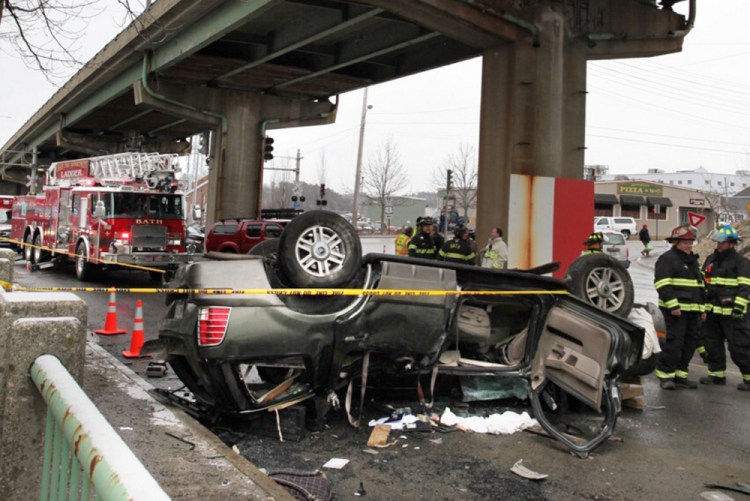The snow- and ice-coated Route 1 viaduct in Bath where Melissa Medina crashed through a guardrail this month had not yet been salted, and Medina was traveling too fast for the slippery road conditions, according to an accident reconstruction report by Bath police.
That the road had not been salted contradicts what the Maine Department of Transportation said immediately after the terrifying accident. The department then said its highway crew had salted the road just a few minutes before the crash because snow was falling.
Maine DOT plow trucks, which also apply salt to roads, are equipped with GPS systems that relay their position to agency officials, as well as whether they are applying salt or sand.
Police wrote in the report, which was given to the Portland Press Herald on Friday, that Maine DOT trucks had not yet reached the viaduct at the time of the accident, and that after the crash, two MDOT trucks helped block traffic around the accident site on the viaduct.
“Deputy Mark Anderson of Sagadahoc County Sheriff’s Office had been the first officer up on the viaduct to secure the scene, which was eventually blocked by MDOT salt trucks (they’d been out salting but hadn’t yet covered the viaduct),” the report said.
Although Bath police initially estimated Medina, of Windham, was traveling at or close to the speed limit of 35 mph, the report makes no definitive statement on her speed, and she has not been cited for any traffic violations. A witness said traffic on the viaduct at the time was flowing slower than usual.
The 11-page report also offers new insight into how Medina’s 2003 Mercury Mountaineer broke through the guardrail, flipped over and plummeted 40 feet, landing upside down in the bed of a pickup truck stopped in traffic below. The Ford F-150 pickup was partially flattened in the crash, but likely saved the lives of Medina and her 12-year-old son, who was riding in the front passenger seat of the SUV, according to the investigators.
Witnesses quoted in the police report said the roughly 4,500-pound, rear-wheel-drive SUV flipped up into the air, appeared for a moment as if it might land back on the viaduct, and then went through the guardrail.
Only after the Portland Press Herald examined the viaduct and found several dozen missing or broken bridge rail bolts on the 58-year-old span did state officials order a closer examination of the Bath viaduct railings and the roughly 30 other bridges in the state that share that railing design, the results of which are still pending.
The state’s follow-up inspection of the viaduct found similar damage to the rail, but found that overall, the bridge rail system was in good condition.
After the newspaper’s examination, the agency also suggested that the state may retrofit old bridge railings of the same design that do not meet current crash test standards. In an earlier interview, the agency had said it had no specific plan to retrofit such bridge rails.
Asked Friday afternoon to clarify whether Maine DOT trucks salted the road before the crash and what the department’s protocol is for treating roads before icy or snowy weather, spokesman Ted Talbot said he had not received the full crash report – police sent him only three of 11 pages – and could not offer an immediate explanation of why he said the viaduct had been salted before the crash.
Later Friday, about two hours after a reporter emailed Talbot the full crash report, he sent the following statement:
“Due to the multiple inaccuracies included in the Bath viaduct story and despite repeated efforts to ensure the reporter was able to comprehend the material given to him, combined with an apparent conflict of interest with a Portland Press Herald advertiser, MaineDOT will no longer be participating in gathering information on this subject,” Talbot wrote. “MaineDOT will continue to provide a safe and reliable transportation system, staffed by highly qualified and dedicated professionals.”
Talbot did not explain what he believed those inaccuracies were, what material the reporter was not able to comprehend, or which Portland Press Herald advertiser presented an apparent conflict of interest. After submitting the statement, Talbot did not respond to multiple requests for clarification or comment.
In general, bridge rails perform the same safety function as guardrails built along ground-level roads. The designs have changed dramatically since the 1940s and 1950s, adapting to evolving understanding of how vehicles react during crashes and to changes in vehicle design. In the 1950s, cars and trucks typically had lower centers of gravity and traveled at slower speeds than they do today.
According to ratings of vehicle stability released by the federal government, Medina’s SUV has a center of gravity roughly 27.75 inches above the ground, in the same range as most light trucks and SUVs driven in the United States. The Mountaineer is a rebranded version of the popular Ford Explorer, and in that model year, both vehicles rated near the middle of the pack in stability ratings of similar vehicles.
The Bath viaduct was built in 1958, but it was not until 1991 that crash tests of roadside safety systems such as guardrails and bridge rails became mandatory. The Maine DOT plans to replace the viaduct this year at a cost of $15 million.
The viaduct’s bridge rail rises roughly 34 inches above a small curb, according to the accident report, and about 50 feet of the viaduct railing was destroyed in the crash, with some pieces left hanging from a nearby tree.
The bridge rail that will be installed on the new viaduct will be higher, roughly 42 inches, and built of steel, a stronger material than aluminum. The new rail will also feature smooth, uninterrupted horizontal beams that allow cars to slide against them.
The aluminum design on the bridge now has exposed edges at each post, which are spaced about six feet apart.
Send questions/comments to the editors.





Comments are no longer available on this story